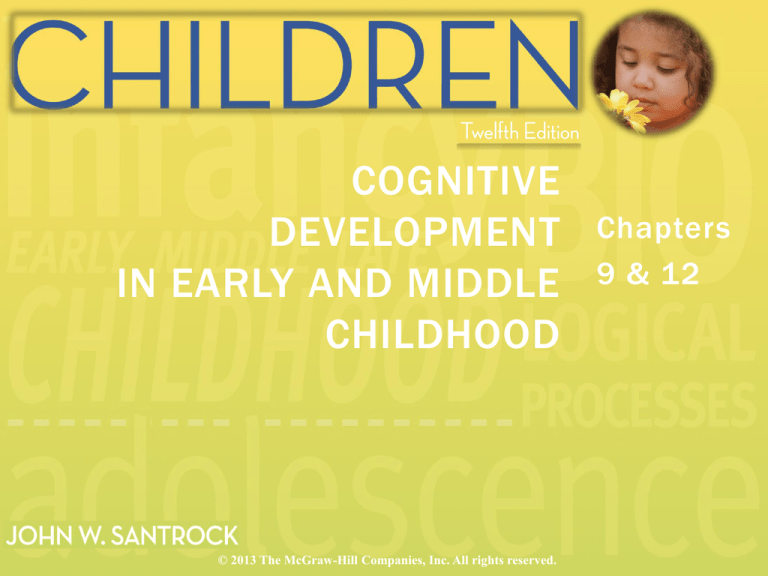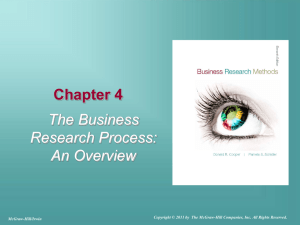
COGNITIVE
DEVELOPMENT
IN EARLY AND MIDDLE
CHILDHOOD
© 2013 The McGraw-Hill Companies, Inc. All rights reserved.
Chapters
9 & 12
JEAN PIAGET’S
PREOPERATIONAL STAGE
COGNITIVE ABILITIES IN
PREOPERATIONAL STAGE
• Symbolic thought and play
• Pretend play
• 12-13 months – familiar activities; i.e. feed themselves
• 15-20 months – focus on others; i.e. feed doll
• 30 months – others take active role; i.e. doll feeds itself
• Imaginary Friends
• More common among first-born and only children
© 2013 The McGraw-Hill Companies, Inc. All rights reserved.
LOGIC AND
THE PREOPERATIONAL CHILD
• Lack of logical operations
• No flexible or reversible mental operations
• Stages:
• Symbolic Function (Preconceptual) 2-4 years
• Intuitive 4-7 years
© 2013 The McGraw-Hill Companies, Inc. All rights reserved.
PIAGET’S PREOPERATIONAL
STAGE
• Preoperational stage: Piaget’s second stage,
lasting from 2 to 7 years of age, during which
time children begin to represent the world with
words, images, and drawings
• Operations: Internalized set of actions; Mental
manipulations of concepts and ideas
© 2013 The McGraw-Hill Companies, Inc. All rights reserved.
PIAGET’S PREOPERATIONAL
STAGE
• Symbolic function stage
• First substage of preoperational thought
• Occurs in ages 2 to 4, imaginative drawings
• Ability to mentally represent object not present
• Thoughts limited by beliefs:
• Egocentrism
• Animism
© 2013 The McGraw-Hill Companies, Inc. All rights reserved.
THE THREE-MOUNTAINS TEST
Figure 9.1
PIAGET’S PREOPERATIONAL
STAGE
• Intuitive thought substage
• Uses primitive reasoning, seeks answers to all
• Occurs about 4 to 7 years of age
• Limits in preoperational thought
•
•
•
•
Centration
Lack of Conservation
Irreversibility
Lack of Class Inclusion
© 2013 The McGraw-Hill Companies, Inc. All rights reserved.
CONSERVATION
Figure 9.2
CONSERVATION OF NUMBER
Figure 9.3
LACK CLASS INCLUSION
• Class inclusion means separating things into main classes as
well as subclasses.
• Requires child focus on more than one aspect of situation at once
• Cannot think about two subclasses and the larger class at the same
time
© 2013 The McGraw-Hill Companies, Inc. All rights reserved.
CLASS INCLUSION
THE CONCRETE
OPERATIONAL STAGE
CONCRETE OPERATIONAL
THOUGHT
• Concrete operational stage; ages 7-11
• Reversible mental actions applied to real, concrete
objects
• Focus on several characteristics at once
© 2013 The McGraw-Hill Companies, Inc. All rights reserved.
CONCRETE OPERATIONAL ABILITIES
• Conservation skills
• Object can have several properties or dimensions
• Child can de-center and focus on more than one
dimension
• Horizontal Decalage
• Conservation of mass develops first
WHAT IS MEANT BY THE STAGE OF CONCRETE
OPERATIONS?
• Beginnings of adult logic
• Capable of operational thinking
• Involves tangible objects, not abstract ideas
• Characterized by
• Reversibility and flexibility
• Less egocentric
• Decentration
• Transitivity
VYGOTSKY’S THEORY
• Social constructionist approach
• Focuses on cognitive development
• Children - Active construction of knowledge and
understanding by actions and interactions
• Depends on tools used by society
• Shaped by cultural context
© 2013 The McGraw-Hill Companies, Inc. All rights reserved.
VYGOTSKY’S THEORY
• The Zone of Proximal Development (ZPD)
• Lower limit - What child achieves independently
• Upper limit - What can be achieved with assistance of
able instructor
• Cognitive skills in process of maturing
• Scaffolding: Changing level of support over course of
teaching session to fit child’s current performance level
© 2013 The McGraw-Hill Companies, Inc. All rights reserved.
VYGOTSKY’S THEORY
• Language and thought
• Children’s language uses solving tasks and social
communication
• Plans, monitors, guides behavior
• Private speech: self-regulation
• All mental functions have external, social origins
© 2013 The McGraw-Hill Companies, Inc. All rights reserved.
VYGOTSKY’S THEORY
• Teaching strategies
•
•
•
•
•
Assess and use child’s ZPD in teaching
Use more-skilled peers as teachers
Monitor and encourage private speech use
Place instruction in meaningful context
Transform classroom with Vygotsky’s ideas
© 2013 The McGraw-Hill Companies, Inc. All rights reserved.
VYGOTSKY’S THEORY
• Evaluating the theory:
•
•
•
•
•
Inner speech important to development
Social interaction affects learning/knowledge
Extends ‘endpoint’ of cognitive development
Teachers serve as facilitators, Piaget agrees
Criticisms:
• Age-related changes not specific enough
• Over-emphasized role of language
• Socioemotional-cognitive link needs more
© 2013 The McGraw-Hill Companies, Inc. All rights reserved.
INFORMATION PROCESSING
• Attention
• Focusing of cognitive resources
• Visual attention dramatically increases during
preschool years; still has deficits
• Executive attention: Action planning, focus on
goals, detects errors, deals with novel or difficult
circumstances
• Sustained attention: Focused, extended engagement
with object, task, event
• Selective attention: Pay attention to relevant features
of a task
© 2013 The McGraw-Hill Companies, Inc. All rights reserved.
DEVELOPMENT OF SELECTIVE ATTENTION
• Ability to focus attention and screen out distractions
improves over time
• Early Childhood
• Attention dramatically increases, but children still ignore salient
information for more flashy information.
• Plannfulness: Haphazard strategies in problem-solving
• Middle Childhood
• Control: Increases dramatically from 6-9
• Adaptability: Flexible, adjust to situation and to own learning
• Planfulness: Can order how they attend to things.
THE STRUCTURE OF MEMORY
Figure 12.4
TYPES OF MEMORY
• Sensory Memory
• Fraction of a second
• Original sensory form
• Working or Short-term Memory
• 7+/- 2 chunks of information by adolescence
• 5- or 6-year-old – 5 chunks
• Cognitive strategies used to promote memory
• Long Term Memory
• Unlimited in Capacity and Duration
• Organization in long-term memory
• Recall memory is improved by categorization
INFORMATION PROCESSING
• Memory
• Explicit memory
• Episodic
• Semantic
• Implicit memory
• Procedural
© 2013 The McGraw-Hill Companies, Inc. All rights reserved.
MEMORY IN EARLY CHILDHOOD
• Best for meaningful and familiar events
•
•
•
•
As young as 11 months remember sequences just experienced
16 months can reenact sequence after delay of 6 weeks
By 4 years, can remember events up to 18 months earlier
Less likely than older children to reject false suggestions about
events
• STM
•
•
•
•
Increases from 2 digits at 2 years old to 5 digits for 7 year old
Better able to transfer information to LTM
More room to process information
Speed increases
© 2013 The McGraw-Hill Companies, Inc. All rights reserved.
FACTORS THAT AFFECT MEMORY IN
EARLY CHILDHOOD
• Types of Memory
• Memories for activities better than for objects
• Interest Level
• Individual interest and motivation
• Retrieval Cues
• Younger children depend on retrieval cues from adults
• Parental elaboration improves child’s memory
• Types of Measurement
• Younger children are limited in measurement by use of verbal
reports
© 2013 The McGraw-Hill Companies, Inc. All rights reserved.
MEMORY STRATEGIES
• Strategies for Remembering
• Rehearsal
• Not used extensively until age 5
• Concrete memory aids used by young children
• Looking, pointing, touching
• Moving information to long-term memory
•
•
•
•
Rehearsal
Elaboration
Organization skills
Use of Memory Strategies
© 2013 The McGraw-Hill Companies, Inc. All rights reserved.
ADVANCED SKILLS IN MIDDLE
CHILDHOOD
• Metacognition
• Knowledge and control of cognitive abilities
• Metamemory
• Children’s awareness of the functioning of their
memory
• As children develop they utilize more strategies
for memory
INFORMATION PROCESSING
• Strategies and Problem Solving
• Strategies: deliberate mental activities to improve
processing information
• Toddlers can learn a strategy
• Early childhood: stimulus-driven changes to goaldirected problem solving
• Some cognitive inflexibility in ages 3 to 4 due to lack
of understanding
© 2013 The McGraw-Hill Companies, Inc. All rights reserved.
INFORMATION PROCESSING
• The Child’s Theory of Mind
• Awareness of mental processes of self, others
• Ages 18 months to 3 years, child understands three
mental states are related to behavior
• Perceptions
• Emotions
• Desires
• Ages 3-5: realizes there are ‘false beliefs’
• Ages 5-7: deeper appreciation of mind itself
© 2013 The McGraw-Hill Companies, Inc. All rights reserved.
FALSE BELIEFS
Figure 9.5
INFORMATION PROCESSING
• The Child’s Theory of Mind
•
•
•
•
Ages 5-6: knows different experiences exist
Age 7: realizes knowledge is subjective
Theory focuses on preschool years to age 7
Individual differences include: number of siblings,
disabilities, parental interactions
• Important developments occur after age 7
© 2013 The McGraw-Hill Companies, Inc. All rights reserved.
INFORMATION PROCESSING
• Theory of Mind and Autism
• Autism: in 2-6 of every 1,000 children
• Linked to genetic and brain abnormalities (impairment
ranges from severe to mild)
• Difficulty in social interactions and developing theory
of mind affected by:
• Inability to focus
• Some general intellectual impairment
• Some areas of brain may be above normal
© 2013 The McGraw-Hill Companies, Inc. All rights reserved.
UNDERSTANDING
PHONOLOGY AND MORPHOLOGY
• Preschool years:
• Increased sensitivity to spoken sounds and ability to
produce sounds of their language
• Vowels, consonants (simple, complex)
• Notice rhymes, poems, silly names
• Knows morphological rules
• Learn and use rules of syntax
• Vocabulary development is dramatic
• By 1st grade: knows 14,000 words
© 2013 The McGraw-Hill Companies, Inc. All rights reserved.
ADVANCES IN PRAGMATICS
• Age, maturity improve language skills
• Better conversationalists
• Engage in extended discourse
• Learn culturally-specific rules, behaviors
• Talk more about events in time, absent objects and persons
• Ability to change speech style to fit situation develops
by age 4-5; more polite and formal
© 2013 The McGraw-Hill Companies, Inc. All rights reserved.
YOUNG CHILDREN’S LITERACY
• Re-examining early education in U.S.
• Concerns about abilities to read and write
• Supportive environment needed earlier
• Precursors to literacy and academic success:
•
•
•
•
•
Language skills
Phonological and syntactic knowledge
Letter identification
Conceptual knowledge about print
Conventions and functions of print
© 2013 The McGraw-Hill Companies, Inc. All rights reserved.
VARIATIONS IN EARLY
CHILDHOOD EDUCATION
• 38 states publicly fund preschool programs
• Child-centered Kindergarten
•
•
•
•
Educate the whole child
Instruction: interests, needs, learning style
Stress how learned; not what is learned
Play is important, various activities used
© 2013 The McGraw-Hill Companies, Inc. All rights reserved.
VARIATIONS IN EARLY
CHILDHOOD EDUCATION
• Preschool programs
• Montessori approach
•
•
•
•
Considerable freedom and spontaneity
Encourage decisions, teacher as facilitator
Self-regulated, independent problem solving
Effective time management, responsibility
• Criticisms:
• Deemphasizes verbal interaction, neglects social development,
restricts imagination
© 2013 The McGraw-Hill Companies, Inc. All rights reserved.
VARIATIONS IN EARLY
CHILDHOOD EDUCATION
• Developmentally appropriate education
• Children
• Learn best from active, hands-on teaching
• Need individual differences considered
• Need socioemotional development
• Developmentally inappropriate education
• Rely on abstract paper-and-pencil activities
• Extensive use of rote drills, seatwork, tests
© 2013 The McGraw-Hill Companies, Inc. All rights reserved.
EDUCATING YOUNG CHILDREN
WHO ARE DISADVANTAGED
• 1965 - U.S. tries to break cycle of poverty
• Project Head Start
• To provide opportunity for children from low -income families
to acquire experiences, skills important for school success
• Not all programs are created equal
• Most provide quality childhood education
© 2013 The McGraw-Hill Companies, Inc. All rights reserved.
CONTROVERSIES IN
EARLY CHILDHOOD EDUCATION
• The curriculum
• Universal preschool education
• School readiness
© 2013 The McGraw-Hill Companies, Inc. All rights reserved.
DIVERSITY IN CHILDREN’S
DEVELOPMENT
• Japan
• Preschools - Little emphasis on academics
• Experience being a member of the group
• Kindergartens have specific aims
• Identical uniforms and caps worn
• Classrooms: identical in equipment
• In large cities: kindergartens tied to universities
• Outside U.S.: children given fewer choices
© 2013 The McGraw-Hill Companies, Inc. All rights reserved.









